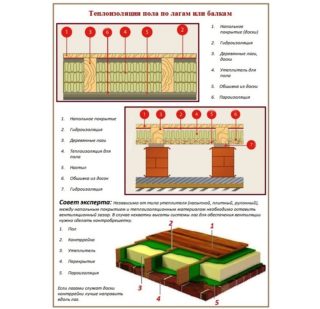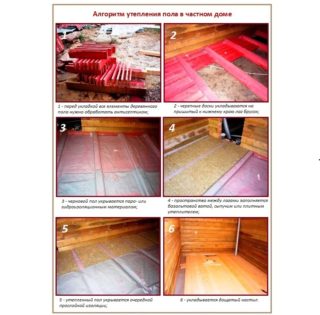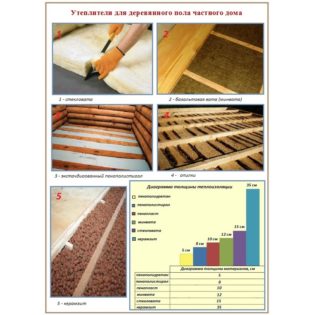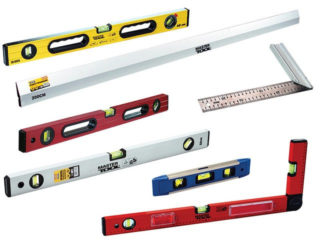Often, the harvest season continues until the first frost. Staying overnight at sub-zero temperatures in an insulated summer house is quite uncomfortable. The use of modern insulating materials can independently reduce the heat loss in the room. When warming the walls and ceiling, one should not forget that the cold penetrates into the room from below through the floor covering.
Selection of materials and tools
First of all, you should familiarize yourself with the technical characteristics of modern materials offered for insulation.
- Expanded clay - is used as a backfill on a draft or concrete floor.
- Polyfoam - has good vapor and thermal insulation. The only drawback is the tendency to crumble.
- Expanded polystyrene and polystyrene - have excellent thermal insulation qualities.
- Mineral wool - is used quite often between the basement and the floor of the first floor.
- Ecowool - made from paper waste impregnated with an antiseptic and flame retardants.
- Fiberboard - is a mixture of wood fibers, water glass and cement. Hygroscopic, therefore, a waterproofing device is required. Recommended laying of a layer not less than 15 cm.
- Izolon - roll insulation made of foamed polyethylene. It has low thermal conductivity and good sound insulation.
- Penofol - insulation with a thin layer of foil that prevents heat loss. Resistant to heavy physical exertion.
A special tool for laying thermal insulation is not required, the material is easily cut with a sharp knife. For the manufacture of rough and fair floors, a standard set of carpentry tools is useful:
- mounting;
- ax;
- hammer;
- chisel;
- building level;
- saw;
- plane;
- screwdriver.
Significantly speed up the use of electrical tools. A small circular saw and screwdriver will be of great help.
Sub floor insulation
 Making a rough floor is easy. A timber 2x2 cm in size is attached to the bottom of the lag with screws, on which thin boards, sheets of plywood or USB, cut to size, are laid. If the logs are small in height, it is better to use an aluminum or steel corner instead of a beam. All wooden parts of the subfloor must be treated with an antiseptic to prevent the appearance of fungus and rot of wood.
Making a rough floor is easy. A timber 2x2 cm in size is attached to the bottom of the lag with screws, on which thin boards, sheets of plywood or USB, cut to size, are laid. If the logs are small in height, it is better to use an aluminum or steel corner instead of a beam. All wooden parts of the subfloor must be treated with an antiseptic to prevent the appearance of fungus and rot of wood.
As a waterproofing, roofing material or a plastic film is used, which is laid on the draft floor between the logs. The edges of the film are bent, lagged and fastened with a construction stapler. Joints between the film are overlapped by at least 100 millimeters.
Insulation is adjusted and laid on the prepared surface. The easiest way to work is with mineral wool, which has a loose structure, or with bulk components. Sheet thermal insulation requires a more careful fit of the joints or the use of mounting foam. The installed insulation must be flush with the top of the log or slightly lower so as not to interfere with the installation of the finishing floor.
Before installing the floor, another waterproofing layer of plastic film is laid on top of the laid insulation to prevent moisture from entering from above. Flooring boards are laid on the logs or a raised floor is mounted from sheets of plywood or fiberboards under linoleum or laminate.
Warming on a wooden floor
 If the height of the room allows, an existing wooden flooring can be used as a rough floor.For insulation, it is recommended to use sheets of expanded polystyrene with a thickness of 5 centimeters, which have a low coefficient of thermal conductivity. It is necessary to carefully dismantle the baseboard and remove all interior doors from the canopies.
If the height of the room allows, an existing wooden flooring can be used as a rough floor.For insulation, it is recommended to use sheets of expanded polystyrene with a thickness of 5 centimeters, which have a low coefficient of thermal conductivity. It is necessary to carefully dismantle the baseboard and remove all interior doors from the canopies.
Lay a waterproofing film on the floor. Fasten additional logs from a 50x50 mm timber to the prepared surface with screws with an interval corresponding to the width of the insulation sheet, this will avoid unnecessary cutting of the panels. Expanded polystyrene has special joining grooves on which immediately before installation a thin layer of polyurethane foam is applied, which ensures a tight connection from the penetration of cold.
On top of the laid insulation, a finishing layer of waterproofing is arranged. Depending on the intended finishing coating, the installation of wood-fiber boards or floorboards is carried out.
When using penofol 10 mm thick as a heater, there is no need to install a beam. The material is laid directly on the wooden floor with the foil facing up. The seam of the stacked sheets is butt glued with metallic tape. On top of the insulation, plywood sheets are installed and fastened with screws to the wooden floor. Finished flooring is laid on the fabricated base.
Concrete floor thermal insulation technology
Concrete has a high thermal conductivity and is a good conductor of cold. In order to quickly and efficiently insulate the floor in the country, made of concrete, modern technologies and insulating foam materials should be used.
A damper tape is mounted on the bottom of the walls around the entire perimeter of the room, which will compensate for temperature changes in the floor structure. The concrete surface is leveled with a small layer of mortar screed. On a leveled surface, panels of extruded polystyrene foam are laid in one or two layers, on top of which a plastic film is laid. Joints of the film, overlapped with an overlap of 100-150 mm, are carefully glued with tape. Next, a reinforcing mesh is laid and poured with a self-leveling solution. After the screed hardens, the final flooring is laid.
When choosing a method of floor insulation in the country should take into account the technical condition of the existing coating, building structure, year of construction and other nuances. Undoubtedly the easiest way that does not require large expenses and dismantling the coating is insulation on a wooden floor, which is not difficult to do with your own hands.





